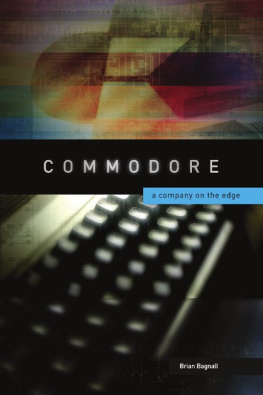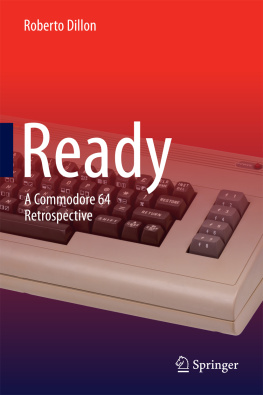VARIANT PRESS
www.variantpress.com
Copyright 2011 by Brian Bagnall
All rights reserved, including the right of reproduction in whole or in part in any form.
Photographs courtesy of Raymond J. Feagans, Neil Harris, Yash Terakura and Dave Haynie.
Library and Archives Canada Cataloguing in Publication
Bagnall, Brian, 1972- Commodore : a company on the edge / Brian Bagnall. -- 2nd ed.
Previously published as: On the edge.
Includes bibliographical references and index.
ISBN 978-0-9738649-6-0 (hardcover)
1. Commodore International--History.
2. Computer industry--Canada--History.
3. Computer industryUnited States--History.
2 I. Title.
INTRODUCTION
Do you remember? I do. - Bouncing Souls, 87
Commodore Business Machines ended operations on April 29, 1994. Enough time has passed to examine what Commodore meant to the world.
Amid the chaos, infighting and excitement, Commodore was able to achieve some remarkable industry firsts. It was the first major company to show a personal computer, before even Apple and Radio Shack. It sold a million computers before anyone else. It released the first true multimedia computer. Yet with all these firsts, Commodore receives almost no credit as a pioneer.
The history of early computers has tended to focus on Microsoft, IBM, and Apple, snubbing contributions made by Commodore. There is a lot of revisionism going on and I dont think its fair, says Commodore 64 designer Robert Yannes. People wanted to ignore Commodore.
An early-popularized story of the microcomputer revolution was Accidental Empires, by Robert X. Cringely (born Mark Stephens). The former Apple employee perpetuated a select view of the microcomputer revolutiona view that not everyone accepts as accurate. In Infinite Loop, Michael Malone writes, The pseudonymous Cringely is notorious for his sloppy way with facts.
In his book, Cringely said, Commodore wasnt changing the world; it was just trying to escape from the falling profit margins of the calculator market while running a stock scam along the way. In reality, Commodore employees worked tirelessly to deliver state-of-the-art technology to its customers at prices far lower than Apples.
PBS adapted Cringleys book as a popular TV series, Triumphof the Nerds (1996). The adaptation ignored Commodore completely.
Turner Network Television produced a movie called Pirates ofSilicon Valley (1999), based on a more credible book, Fire inthe Valley, by Paul Freiberger & Michael Swaine. Regrettably, the producers ignored much of the book and focused on Steve Jobs, Bill Gates, and IBM.
The PC came out, we changed players, and the whole early history just got lost, says PET designer Chuck Peddle. Peddle deplores the emphasis on IBM, Apple, and Microsoft at the expense of earlier developers. None of that is true. Its not fair that the stuff that happened earlier has been so badly ignored.
Im not sure its intentional, its just the west coast mindset that everything happens on the west coast, so we dont even need to pay attention to what happened everywhere else, says Yannes. Most of the revisionist stuff I read was coming out of California and Commodore was mostly successful after it left California.
When writers are not ignoring Commodore, they often get their facts wrong. In The Silicon Boys and their Valley ofDreams, David Kaplan describes the Apple IPO in 1980 and then adds, But Apple soon bred competition. Radio Shack and Commodore and even Atari, among others, started selling their own personal computers. In truth, Commodore and Radio Shack began selling personal computers in 1977, and Atari followed in 1979.
This rosy picture of Apple starting the microcomputer industry crumbles under inspection. Apple had a very slow start and eventually climbed to first place sometime in the early 1980s, only to lose its lead to Commodore once again. In the very earliest days, Commodore was pioneering the consumer microcomputer industry.
While IBM pushed business computers and Apple pushed style, Commodore put computers into the hands of ordinary consumers. Throughout the eighties, Commodore consistently had the best prices, often with the best technology. The Commodore 64 is the Model T of computers, selling more units than any other single computer model, according to the Guinness Book of World Records.
In the summer of 2004, I began interviewing Commodore insiders. We traveled back to the seventies, eighties, and nineties and relived the Commodore experience. I am thankful to each of the participants for taking me on that journey, something I will never forget.
The journey has ended for me, but for you it is about to begin. I hope you enjoy reading this book as much as I enjoyed writing it.
PROLOGUE
The Rise of Commodore
Hailing a taxi in New York City in the early 1950s might have put you in the company of future business titan Jack Tramiel. As you sat in the back seat, two large, bulging eyes would appraise you through the rearview mirror, determining if you were worth anything to him. At the time, Tramiel was positioning himself for riches and glory. It was a humble beginning, but driving a taxi was a blissful step up from the work camps in Poland during World War II.
In July 1947, a 19-year-old Idek Tramielski proposed to and married a fellow concentration camp survivor named Helen Goldgrub in Germany. While there, the Hebrew Immigrant Aid Society contacted Idek and helped him and his wife emigrate from Europe by paying for their ocean liner tickets to New York City. Idek changed his name to Jack Tramiel.
In 1948, Tramiel enlisted in the US Army and served as a cook at Fort Dix. Later, he joined the First Army Office Equipment Repair Department, which was responsible for maintaining and repairing almost 25-thousand pieces of office equipment. Tramiel served two tours of duty in Korea in 1950 and in 1952.
After his service ended, Tramiel worked for a typewriter repair company called Ace Typewriter. There, he met a fellow technician named Manfred Kapp, and the two started a repair company called Singer Typewriter.
In 1958, Tramiel, Kapp, and their families moved to Toronto, Canada and formed a typewriter manufacturing company called Commodore. People sometimes got a little bit frightened of him because he was moving and talking a little bit too fast, says Kapp. The company quickly grew until a scandal rocked the Canadian financial scene, with Commodore at the center. After an embarrassing public inquiry, Commodore was finishedor so it seemed.
In 1966, a Canadian Investor named Irving Gould purchased Commodore and redirected Tramiel into the burgeoning calculator business. By 1973, savage competition from Texas Instruments and Japanese calculator manufacturers began hurting Commodores profits. Tramiel began to look elsewhere for cheaper calculator parts.
CHAPTER 1
Microprocessors
1973-1974
High-tech companies need three players in order to succeed: a financier, a technology god, and a juggernaut with a Type A personality.
Commodore would require these three ingredients to take them to a new level. They had Irving Gould, with his financial expertise and deep pockets. They had Jack Tramiel, so aggressive people sometimes referred to him as the scariest man alive. All Commodore needed was a visionary engineer to take Commodore into a new field of technology.
In the 1970s, the image of a computer genius was not in the mold of the young hacker. Teenaged tycoons like Bill Gates had not yet filtered into the public consciousness. Instead, the accepted image of a technological genius was a middle-aged man with graying hair and glasses, preferably wearing a long white lab coat and working at Hewlett-Packard or 3M.
Next page








